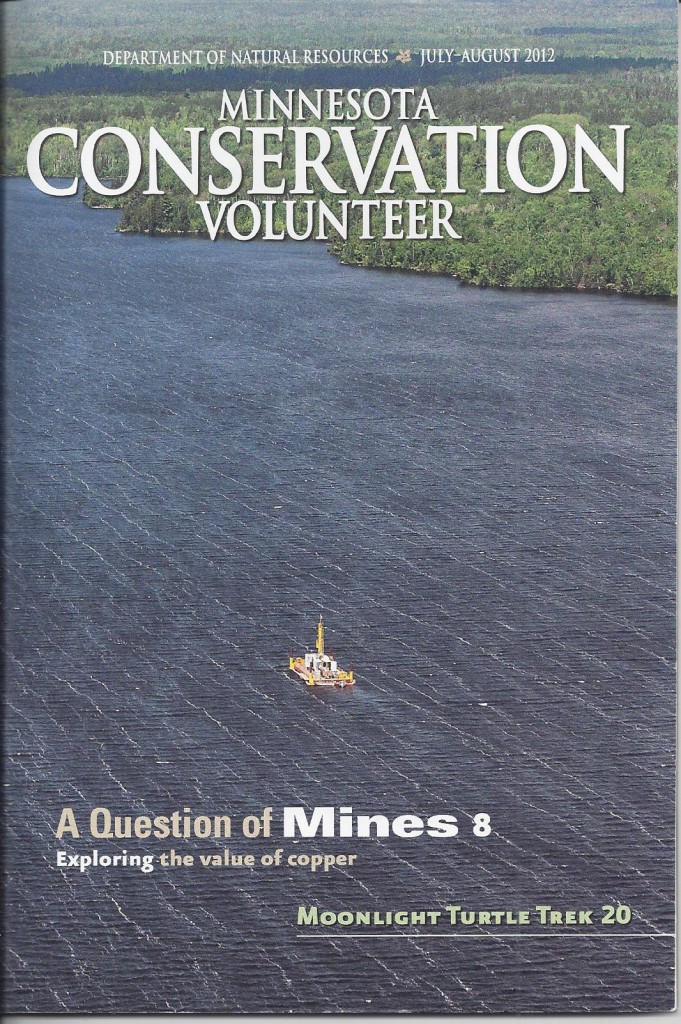 Mr. Tom Coombe, Editor,The Ely Echo, Ely, MN
Mr. Tom Coombe, Editor,The Ely Echo, Ely, MN
Dear Mr. Coombe: 30 July, 2012
I have just received my copy of the July-August issue of Minnesota Conservation Volunteer magazine (shown here, of the exploration drill rig in Birch Lake)
with an editorial and an article by John Myers on metallic sulfide mining in the forests and lakes of northeastern
Minnesota. As a homeowner in the area I was gratified to have them write about this issue but I was appalled
at how little attention was given to the very troublesome nature of much of the information available about this
mining endeavor.
For example, the article mentions the possible value of the minerals in the Duluth formation but
neglects to mention that the concentration of copper and other metals is extremely low, 1% or less by weight.
This means that for every ton of ore removed, only 20 pounds of metal will be obtained. The other 1980 pounds
are waste, which must be disposed of into the environment and in addition, the disposal is independent of that
of the overburden. But this is an oversimplification. The processes of obtaining copper from ore from open-pit
or underground mines involves pulverizing the ore to the texture of talcum powder. This increases the volume
of the waste enormously, making it necessary to store the waste above ground in tailing ponds. So the premise
that underground mines will be less polluting doesn’t apply to these mining methods.
But even this too is an oversimplification as both the ore and its wastes are complexed with sulfide. No matter what efforts at
remediation are taken, sulfide will react with water to generate sulfuric acid which will leach from tailing ponds
or other storage methods to contaminate ground water, wet lands, streams, rivers and lakes. Nowhere on earth
has metallic sulfide mining been done in a manner such as to avoid environmental contamination.
Why should we believe any mining company who says their methods of metallic sulfide mining will not
lead to environmental degradation? And the fact that the proposed mine sites abut the Superior National Forest
and the Boundary Waters Canoe Area adds even more anxiety about these endeavors.
The article mentions Mr. Skradski’s comments on mining saving Ely, perhaps he should have
considered Virginia, Minnesota, with three mines operating and a community nonetheless in economic distress.
The notion that this project will provide 5000 permanent jobs leads to the question what overall size
of operation will require a staff of this size? And imagine what area of tailing ponds will be required for this vast
an operation, and how much pollution will be generated by it.
The companies who propose to do this work are not US companies but have foreign ownerships, so
the profits will leave the US. The proposed mines have a life-span of approximately 20 years. The land and
water that they will damage have lifetimes measured in centuries. It is not a worthwhile trade off. We have the
forests, wet lands and water now, they generate unmeasurable profit in the form of atmospheric modulation
by absorbing carbon dioxide, producing habitats for countless animals and wilderness areas for us (humans)
to appreciate and utilize. Who will vacation at a mine site?
We don’t know the true value of the minerals – what happens when we discover alternatives, or
increase copper recycling or other countries provide the minerals at lower cost than we do? It’s a gamble the
outcome of which is clear – the environment loses, the organisms in the environment (including us) lose, the
state loses resources that will take thousands of years to recover if ever. The gain is short term and the profits
accrue to others.
Sincerely yours,
Jonathan Green
Ely, Minnesota 55731

Leave a Reply